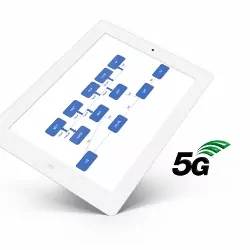
In this article I’m sharing a short overview of the LTE evolution, starting with its introduction within 3GPP Release 8 back in early 2009 up to LTE-Advanced Pro to be finalized in March 2016 within Release 13[1]. Timeline, main features and a maximum throughput calculation is provided for each of the LTE evolution steps.
Timeline
LTE Rel-8 standard was frozen in March 2009. The goal for it was to prepare the mobile system to allow evolutionary change towards 4G as imposed by IMT-Advanced. From the technical point of view, initial LTE release was not a full 4G system.
LTE-Advanced was specified within 3GPP Rel-10. The corresponding standard was frozen in June 2011. LTE-Advanced was defined to fulfill IMT-Advanced requirements, thus is seen as a 4G technology.
“LTE-Advanced Pro” was agreed by 3GPP in October 2015 as a marker for LTE for Rel-13 onwards[2]. The Rel-13 freeze date is March 2016. The new name is used to mark a point where significant improvements with regards to LTE-Advanced are made.
Main features
Rel-8 LTE was initially standardized with the following main set of features:
- OFDMA – to allow sharing and assigning resources in time and frequency domain;
- MIMO – to natively use space dimension for capacity/coverage improvements;
- eNB – a simplified RAN architecture with a single type of node encapsulating features from RNC and NodeB (from the 3G world);
- Operation with FDD and TDD duplex modes;
- Adaptive modulation and coding with QPSK/16QAM/64QAM and turbo codes with variable rates.
- Use of flexible spectrum bandwidth with 1.4MHz to up to 20MHz.
LTE-Advanced is defined in 3GPP as Rel-10, but covers also Rel-11 and Rel-12 adding the following features to the baseline set:
- Carrier Aggregation (CA) – possibility to aggregate multiple Rel-8 Component Carriers (CC) on MAC level to increase system capacity or user throughput with the scheduling flexiblity (initially either FDD or TDD, later with combined FDD and TDD);
- Enhanced MIMO with up to 8 antennas at eNB – to improve spectral efficiency;
- Heterogeneous Networks (HetNet) – network with different types of nodes to allow home usage of LTE and increasing capacity in hotspots. This include such concepts as HeNB and enhanced ICIC
- SON – introducing automation to network operation in the means of Self-Configuration, Self-Optimizaton and Self-Healing;
- Multicast Broadcast Multimedia Services – with the Single Frequency Network (SFN) to allow broadcasting the same service content within different cells using LTE radio;
- Coordinated Multi-Point Transmission/Reception (CoMP) – transmission/reception using different transmission points to address a single UE to improve cell edge users’ performance;
- Enhanced PDCCH – decreasing the dedicated PHY signaling resources by transmitting resource allocation messages within data resources;
- Extending maximum combined spectrum bandwidth to up to 100MHz (i.e. the use of maximum of 5 CCs with 20MHz each).
LTE-Advanced Pro initial features’ set includes the following:
- Enhanced MIMO/PHY Layer
- Elevation Beamforming / Full Dimension-MIMO – allow to use elevation beamforming enhancing the horizontal beam steering, and using up to 64 antenna ports.
- 256QAM – further increasing spectral efficiency to allow transmission of 8 bits per symbol;
- Extension of CA towards Massive CA with up to 32CCs with a mixed blend of licensed and unlicensed spectrum usage;
- New connectivity methods
- Dual Connectivity (DC) – possibility to combine different data links from macro cell and small cell. It uses the PDCP level aggregation.
- Device-to-device (D2D) – direct communication between devices assisted by network by using side-link.
- Usage of unlicensed spectrum
- Licensed-Assisted Access (LAA) – LTE radio usage within unlicensed 5GHz band with new frame type to assure fair coexistence with WiFi;
- LTE-WiFi Aggregation (LWA) – aggregation of links using both LTE and standard WiFi system where the data is split on PDCP level.
Magic throughput values
As we all know, to improve the attractiveness of each new system/release (but also to show the maximum capability of the technology) a maximum theoretical throughput in DL is provided.
For LTE it is ~320Mbps, for LTE-Advanced – 3Gbps and LTE-Advanced Pro is expected to extend it further to 4Gbps. An interesting question is: where are the magic numbers comes from?
Let’s take each of them and try to answer this question with simplified calculations:
LTE maximum throughput:
- Maximum DL spectral efficiency = 16bits/s/Hz (with 4 spatial streams using 4 antennas and 64QAM – i.e. 6bits/symbol)
- Maximum BW size = 20MHz
- Maximum throughput = 16bit/s/Hz * 20MHz = 320Mbit/s
LTE-Advanced maximum throughput:
- Maximum DL spectral efficiency = 30bits/s/Hz (increase in number of antennas by 2, i.e. to 8. However spectral efficiency is not improved exactly 2x, due to additional pilots needed)
- Maximum BW size = 100MHz (5 x 20MHz – maximum of 5 component carriers)
- Maximum throughput = 30bits/s/Hz * 100MHz = 3Gbps
LTE-Advanced Pro maximum throughput:
- Maximum DL spectral efficiency = 40bits/s/Hz (8/6 * 30bits/s/Hz, i.e. with the introduction of 256QAM, a maximum of 8bits/symbol can be transmitted instead of 6)
- Maximum BW size = 100MHz (Note: further spectrum enhancements are not included here, e.g. 32CC and unlicensed spectrum usage)
- Maximum throughput = 40bits/s/Hz * 100MHz = 4Gbps
Summary
LTE evolution is pretty exciting area where new features are added to improve current system’s performance and operability, but also to enable new services to be introduced. On the other side, the overall system’s complexity is increased with the new solutions.
What we can observe by looking in the presented features set is that the initial macro network based LTE using new waveform (OFDMA) and multi-antenna usage is evolving towards Heterogeneous Networks increasing used spectrum with the multi-point connectivity, unlicensed spectrum and automated network operation.
To elaborate in more detailed on the current standard status, once the 3GPP Rel-13 is frozen, a full article regarding LTE-Advanced Pro will be provided in this blog. Stay tuned!
(Update: the mentioned article is provided here: “LTE-Advanced Pro – what is this?”)
[1] Grandmetric Ltd is authorized to use the LTE, LTE-Advanced or LTE-Advanced Pro logos and the acronym LTE.
ETSI is the copyright holder of LTE, LTE-Advanced and LTE-Advanced Pro Logos.
LTE is a trade mark of ETSI.
[2] The 3GPP press release about LTE-Advanced Pro can be found here.






